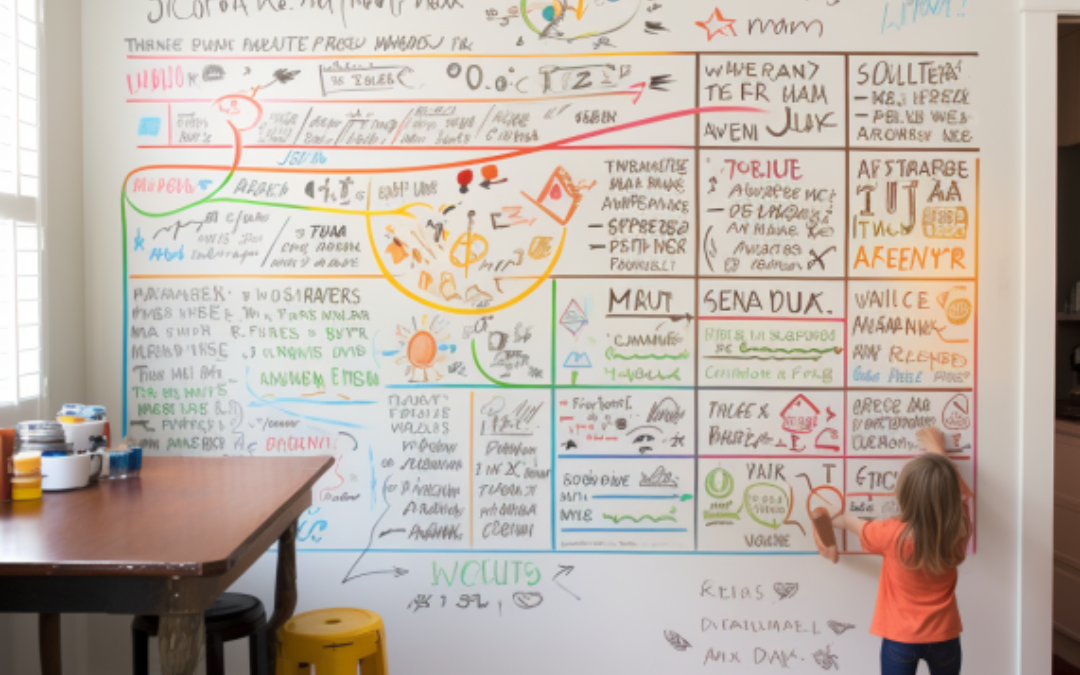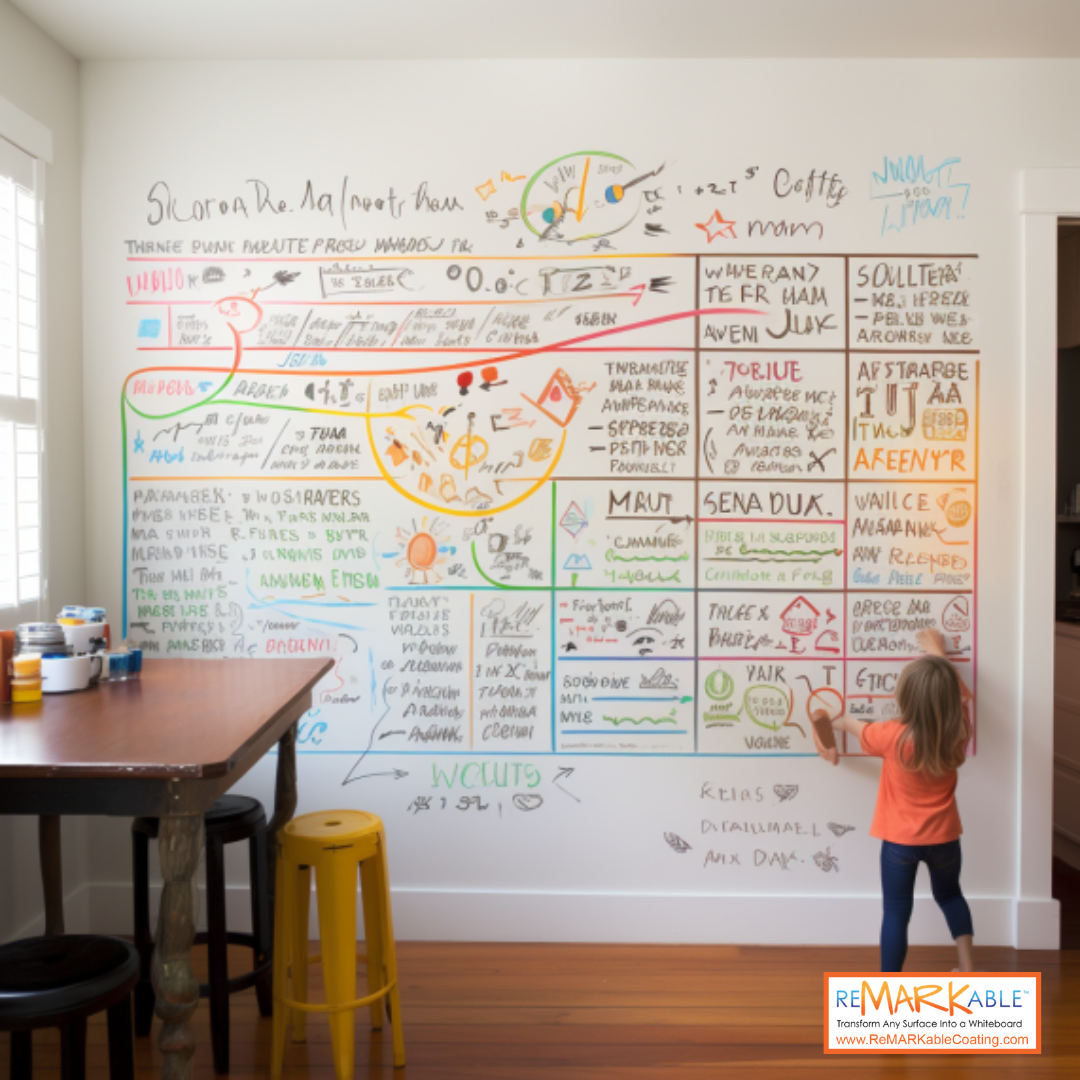Creative Playrooms: Transforming Kids’ Spaces with Dry Erase Paint
In the world of growing children, creativity and education are closely interconnected. Parents and teachers work hard to shape environments that support these elements, leading to the idea of making children’s areas both interactive and educational. A standout innovation is applying dry erase paint to make plain walls into creative canvases. This article explores how dry erase wall paint can transform playrooms and nurseries, providing design suggestions, safety advice, and do-it-yourself projects to create an entertaining and educational space for kids.
The Magic of Interactive Walls
Imagine a wall where your child can draw their wildest dreams, solve Math problems in an instant, or write their first words without any limitations. Dry-erase painted walls offer just that—a limitless canvas for exploration and expression. These surfaces encourage children to think big and get creative with colors, shapes, numbers, and letters—all while making it incredibly easy for parents to wipe away the old drawings or writings and start anew.
Beyond drawing alone, these interactive walls can be used for various educational activities such as spelling games, practicing arithmetic, or even learning Geography by outlining maps right on the wall.
Design Ideas for Playful Learning
When it comes to designing a playroom or nursery with dry erase surfaces, the possibilities are truly endless. Here are some exciting ideas to inspire you:
Themed Walls
Design specific areas on the walls to represent various themes, such as the exploration of space adorned with stars and planets, or vibrant underwater realms filled with colorful fish. These themed backgrounds can be used for engaging in storytelling adventures or playing role-playing games.
Learning Zones
Designating specific areas on the wall for different learning activities can be a great way to organize the learning space. For example, you can set up an “alphabet corner” where kids can practice letters and spelling using erasable markers. Additionally, you could create a “Math zone” where they can solve equations and practice arithmetic. This approach helps structure the learning environment and makes learning more engaging and interactive for the kids.
Art Galleries
Turn your kid’s room into a haven for art enthusiasts by putting up frames on portions of the whiteboard wall, allowing them to display their newest creations with pride. This special space for art will not only inspire your child’s creative side but also build their confidence as they show off their artwork.
To keep the art display interesting and motivating, regularly change the artwork. This practice will fill your child with pride every time they see their work displayed and motivate them to create new pieces continuously.
By setting up this area for artistic expression, you’re helping to cultivate your child’s creative talents and instill a lifelong appreciation for creativity.
Interactive Calendars
Designate a section of the wall for an interactive calendar that’s both fun and educational for children. This engaging tool helps kids learn about days, months, and seasons. With colorful markers, they can also schedule their activities, promoting independence and responsibility. This practical display not only helps keep track of significant dates and events but also motivates children to take part in managing their schedules and teaches them essential time management skills.
Safety Tips for Kid-Friendly Surfaces
While creativity is at the forefront of using dry erase paint in children’s spaces, safety should never take a back seat. Here are some essential tips to ensure these creative playrooms remain safe:
Non-toxic Paints
Always choose high-quality dry erase paints that are non-toxic and free from harmful chemicals. Ensure they’re specifically marked safe for use in children’s environments to guarantee peace of mind.
Low-Odor Markers
Opt for low-odor or odorless markers that are safe for kids to use daily without exposing them to strong fumes or harmful solvents.
Regular Cleaning
Keep the surfaces clean using appropriate cleaners designed not to damage the dry erase finish while ensuring it remains hygienic for children. Regular cleaning will help maintain a pristine surface for endless creativity.
Benefits of Dry Erase Playrooms
Transforming kids’ spaces with dry erase paint offers numerous benefits. Not only does it foster creativity and provide a platform for interactive learning, but it also encourages collaboration, problem-solving, and active participation. Additionally, it allows for easy customization and flexibility in adapting the space for different activities and learning styles.
Below are several benefits of transforming kids’ spaces with dry erase wall paint:
Enhances Fine Motor Skills: When children draw on vertical surfaces such as walls, they improve their fine motor skills by using markers or erasers.
Encourages Collaboration: Interactive walls invite collaboration among siblings or friends during playtime, promoting teamwork and social interaction.
Enhances Cognitive Development: Engaging in educational activities on whiteboard surfaces stimulates cognitive abilities such as problem-solving, critical thinking, and memory retention.
Boosts Confidence: Seeing their artwork displayed on the walls or successfully completing learning tasks gives children a sense of accomplishment and boosts self-esteem.
Easy Cleanup: Unlike traditional art supplies that may leave behind stains or require extensive cleanup, dry erase playrooms offer easy cleanup with just a wipe of an eraser or cloth.
Versatility: Dry erase walls can be easily changed and adapted to different themes or learning activities, providing endless opportunities for exploration and growth.
DIY Projects: Bringing Your Vision to Life
Creating a fun playroom for your kids can be manageable. Explore these simple and practical DIY projects to make an exciting and interactive area for your children:
Wall Preparation
Start by choosing a smooth wall surface; if necessary, apply a base coat of paint before applying two coats of dry erase paint according to manufacturer instructions. This ensures a smooth and durable whiteboard finish.
Sectioning Off Areas
Use painter’s tape creatively on the wall before painting. This will allow you to create distinct sections or frames, such as themed zones or art galleries with defined edges, enhancing visual appeal and organization.
Adding Accessories
Install shelves near the whiteboard walls where little hands can easily access markers, erasers, and other art supplies. This ensures a tidy and organized playroom while encouraging independence in creativity.
Incorporating dry erase paint into kids’ playrooms presents an innovative way to blend creativity with education seamlessly within home settings. By following safety guidelines and embracing some imaginative design ideas, parents can create dynamic spaces that encourage their children’s intellectual growth while keeping them engaged through playful learning activities. Whether through themed walls or designated learning zones, these interactive surfaces promise endless fun and educational opportunities—making every scribble count towards building brighter minds in creatively inspired environments.
So why wait? Let your child’s imagination run wild on the canvas of their very own dry erase painted playroom!



Recent Comments